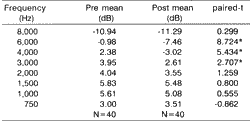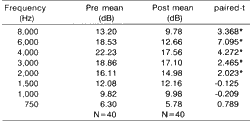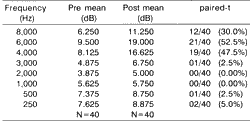

Year: 2001 Vol. 67 Ed. 5 - (7º)
Artigos Originais
Pages: 650 to 654
The influence of loud music on hearing thresholds by the use of personnal cassette players. Study of otoacoustic emissions (distortion product) and audiometry in 40 ears
Author(s):
José A. Médicis da Silveira 1,
Ana L. A. Brandão 2,
Janaina De Rossi 2,
Líscia L. A. Ferreira 2,
Marco A. M. Name 2,
Priscila Estefan 3,
Fabiana Gonçalez 4
Keywords: temporary threshold shift, noise induced hearing loss, otoacoustic emissions, music
Abstract:
Introduction: Transient or permanent cochlear lesions due to exposure to loud intensity music have been studied by a great number of authors. Noise induced hearing loss has been extensively studied using audiometry and otoacoustic emissions (distortion product), but both tests have never been compared. Study design: Prospective clinical no randomized. Aim and Method: The authors aimed at investigating audiometric and otoacoustic alterations and clinical manifestation in 20 volunteers (40 ears) exposed to loud intensity music for 60 minutes using a personal cassette player. Conclusion: The present study confirmed the incidence of Temporary Threshold Shift (TTS) after exposure to loud intensity music, especially in 4 kHz and 6 kHz.
![]()
INTRODUCTION
If we were to make an analogy with the organs of sense, we would say that music is to hearing as perfume is to olfaction. But is it true to say that music only enhances our ears?
Everyday, we see people going on their daily jogging, walking in parks or riding bicycles and carrying personal cassette players or walkman devices. The youth is using this device more and more in their free time, sometimes listening to quite loud music.
Transient or permanent cochlear damage induced by exposure to loud music has been the concern of a number of authors, such as Caldas et al.4, Toledo et al.11, Wong et al.14, Merluzzi et al.7, Vinck et al.13, Lee et al.6, among others. In studies that correlated hearing loss secondary to loud music, however, pure tone audiometry findings and otoacoustic emissions (OAEs) findings were never compared. Since OAEs are the most sensitive test to detect damage to outer hair cells5, which are the main target of acoustic trauma, the present study intends to investigate pure tone audiometry together with distortion product otoacoustic emissions (DPOAEs) to assess hearing disorders and prevalence and duration of symptoms, such as hearing impairment, ear fullness and tinnitus.
MATERIAL AND METHOD
The present study was carried out between May and August 1999, at Clínica Otorhinus - Sao Paulo/SP. We conducted a prospective study of 20 volunteers, represented by residents in Otorhinolaryngology and audiologists, who were aware that the test could bring hearing symptoms, according to the Ethics Committee of the Institution.
We analyzed 40 ears of volunteers whose ages ranged from 22 to 30 years (mean age of 26 years, standard deviation of ± 1.8), divided into 12 female and 8 male subjects. Among the studied subjects, there were no cases of family history of deafness, exposure to ototoxic drugs or hearing loss, and ENT examination was normal. We interviewed all subjects in order to learn more about musical habits (intensity and frequency of exposure) and their musical preferences.
All subjects were studied before exposure with walkman device through pure tone audiometry (Audiometer Maico MA 41), speech discrimination test, immitance measures (Rexton IA-128) and otoacoustic emissions (distortion product - software Scoutplus by Biological), always performed by the same examiner. For each frequency tested with DPOAEs we used three series of stimuli and the measures were unified by calculating a mean of the three measures. Except for two studied ears, in which pure tone thresholds were 25dBHL in 1,000Hz and 6,000Hz, all the other 38 ears presented thresholds up to 20dBHL in all studied frequencies. We did not notice abnormalities in immitance measures. We excluded volunteers who had pure tone thresholds of 25dBHL, because they had borderline results that could lead to mistakes of interpretation.
Next, we exposed the subjects to the use of a walkman device brand AIWA TA 154, with new batteries brand Duracel, for 60 minutes, listening to rock and roll at the maximum intensity tolerated by each of the subjects. The intensity was estimated from the point of maximum sound energy of the first song and varied from 87 to 113 dBHL (mean of 104.35 dBHL and standard deviation of 5.96 dBHL). We used a Sound Level Meter - Radio Shack, coupled to the slow response A position of the walkman device right after the test. After exposure, we repeated otoacoustic emissions and pure tone audiometry. Volunteers were asked to report onset of hearing impairment and/or ear fullness and tinnitus. For seven days, subjects were asked whether they still had the symptoms.
The analysis of the influence of walkman use in the examination of otoacoustic emissions was performed by comparing pre and-post-exposure data using t-paired test (p £ 0.05) for each frequency, aiming at identifying those in which there were statistically significant differences in the responses in the assessment of pure tone audiometry data, for each frequency, we included the number of occurrences in which the variation of the pre and post measures was equal or greater than l0dBHL, a difference adopted as a standard because of the subjectivity of the test.
RESULTS
Considering the alteration of distortion product after the use of walkman devices, statistically significant differences were observed in frequencies 3kHz, 4kHz and 6kHz (Table 1); in the analysis of distortion product subtracted from background noise (DP - RF) for each frequency, we observed statistically significant differences for frequencies 2 to 8kHz (Table 2).
As to the pure tone thresholds in different frequencies, we observed a significant incidence of thresholds differences in frequencies 4kHz, 6kHz and 8kHhz (Table 3).
There was an incidence of 25% of the cases with hearing loss and/or ear fullness after exposure to walkman use; tinnitus was noticed in 72.5% of the ears. The symptoms disappeared in 90% of the ears within 24 hours (33.3% within 30 minutes). Within 48 hours, the last patient reported complete remission of tinnitus.Table 1. Otoacoustic emissions: statistical analysis of results, considering distortion products (amplitude absolute values).
* statistically significant for p £ 0.05.
Table 2. Otoacoustic emissions: statistical analysis of the results, considering distortion product subtracted from background noise (DP - RF).
* statistically significant for p£ 0.05.
Table 3. Pure tone audiometry: means of pre and post-use of walkman device and number of occurrences with pre and post-differences equal or greater than 10 dBHL.
DISCUSSION
It is important to, point out the difference in interests concerning amplification of music at the beginning and end of the millenium. Last century was the hallmark of industrial revolution and in past decades we witnessed the electronic revolution and the advance of communication sciences. It is known that in the Middle Ages there was much concern about amplifying music, especially in cathedrals. At Saint-Étienne Cathedral, in France, whose construction during the 11th century produced a compact architectural style, with high ceiling and columns, was tailored made so that the Gregorian chants would gain body and fill the whole space with its glorious songs (Gregorius I, Pope of the 6th century, advocated the religious chant in unisonous, giving birth to the Gregorian chants). Currently, researchers are concerned about studying not only occupational noise, but also leisure-related noise in an attempt to minimize risks and damage of the inner ear because of noisy activities. Among such activities, we may include exposure to loud music, such as the sound produced by "trios eletricos1", very well studied by Caldas et al. 4, who evaluated the noisy areas where the participants dance and the neighboring buildings in Recife, Pernambuco. In addition to defining mean duration of continuous exposure for each type of group, the authors concluded that there was an eminent hearing risk for the dancers who follow the float and the musicians who play on it. Conversely, the dwellers of nearby regions through where the float passes did not face risks concerning noise-induced hearing loss (NIHL) owing to great variation of sound intensity with time. Another study carried out in Salvador/Bahia9, assessed the hearing loss of workers in "trios eletricos" and musical bands (from drivers to musicians); the authors found a prevalence of NIHL of 40.6% in the studied population. The noise in large cities and even daily common sounds, such as the noise generated by electrical home appliances, were recently studied in Brazil by Toledo et al.11.
From a pathophysiological viewpoint, noise induced hearing loss is essentially sensorineural and, in general, the outer hair cells (OHC) are the first ones to be compromised.
Otoacoustic emissions, as discovered by Kemp in 1978, may be defined as low intensity sounds produced by the outer hair cells either spontaneously or as a response to auditory stimuli (evoked). In the mechanism of an active cochlea, they correspond to the fast contraction of OHC, the main responsible for the cochlear amplification function, in addition to being the mechanism that generates evoked OAEs, such as the distortion product (DP)12.
Since OHCs are the first ones to be affected by an acoustic trauma, otoacoustic emissions test is a very objective tool to detect inner ear damage. Vinck et al.13 evaluated the use of otoacoustic emissions as a quantitative index of functional integrity of OHCs during the mechanism of temporary thresholds shift (TTS) caused by loud music. The authors confirmed the usefulness of distortion product to assess and follow up this kind of alterations, whose results are more evident close to the frequency of 4,000Hz.
We may state that distortion products (DP) reflect the functional status of outer hair cells in areas of the basilar membrane that correspond to the frequencies in-between the two pure tones used as stimuli. For clinical application, both primary frequencies should be geometrically centered close to those normally tested in conventional audiometric tests, constructing the graph named DP-gram3.
According to Alberti1, if OHCs are stimulated with loud sounds, the radicula is temporarily shortened, causing a reversible alteration of the cilia. If temporary, this alteration is known as temporary threshold shift (TTS). Similarly, if the OHCs are stimulated with louder or prolonged sounds, leading to irreversible cell damage, this alteration is named permanent threshold shift (PTS). Merluzzi et al.7 reported that it is likely that a number of TTS could lead to a PTS, as agreed by Lee et al.6.
Merluzzi et al.7 believe that permanence for more than 2 hours in disco clubs would certainly cause a TTS, with hearing impairment, tinnitus and ear fullness reported by some cases. In the same study, the authors referred that the hearing levels of young people in Italy have been decreasing compared to a similar article published in 1987, concluding that we need educational and preventive measures concerning hearing loss, an opinion shared by many other authors8.
Lee et al.6 conducted a study with pure tone audiometry to assess TTS caused by continuous three-hour use of walkman devices, with sound peaks of more than 100dBHL in 16 volunteers; they found alterations in 7 cases that regressed within 24 hours. The authors recommended that preventive measures should be taken also with recreational sounds.
Non-occupational sound exposure has been more and more valued. The Institute of Medical Research on Ear Pathology of United Kingdom, in a review of the literature, revealed that non-occupational noise provided fewer risks of causing damage. Nevertheless, the number of young adults who are expose to this kind of noise (especially the walkman) is very significant, amounting to 5 million people in that region14.
Since health providers, especially otorhinolaryngologists and audiologists, are showing growing concern about inner ear damage caused by loud noise, we carried out a study with a group of volunteers who are investigators in the area, continuously interested and aware of the risks of temporary and permanent alterations caused by noise exposure.
According to the results of the present study with otoacoustic emissions, there were statistically significant differences in absolute amplitude of distortion products in 3, 4 and 6kHz; in distortion products subtracted from background noise, the differences were seen in frequencies 2 to 8kHz. We do not know if the parameter DP-RF is more sensitive to detect OHCs lesions or if the lesion is exclusively located in frequencies 3, 4 and 6kHz, as stated by Axelsson et al.2, or between 2 and 5.5kHz, as reported by Vinck et al.13.
In our study, the occurrence of hearing loss equal or greater than 10 d8 was noticed in frequencies 4 to 8kHz. Pure tone and otoacoustic emissions findings agreed that the frequency most affected by exposure to loud noise was 6kHz, differently from the report by Vinck et al.13 and Wong et al.14, who identified 4kHz as the most affected frequency. Tinnitus, ear fullness and hearing impairment after exposure to loud noise with the walkman regressed within 24 hours in 90% of the cases, in accordance with the data by Lee et al.6.
In view of the findings collected by the present study, we concluded that the use of walkman devices at loud intensities leads to temporary hearing impairment, as noticed in all studied subjects, which was compatible with the TTS detected at otoacoustic emissions test, ear fullness and tinnitus. Taking into account that repetitive TTS may lead to PTS, we believe that the potential harmful effect of abusive use of walkman devices should be communicated to the population.
Our study group decided to go further in this area by studying regular users of walkman devices in an attempt to assess the evolution from TTS to PTS.
CONCLUSION
The present study employed otoacoustic emissions, pure tone audiometry and the clinical picture to confirm the presence of ITS post-exposure to loud intensity music through the walkman device, affecting mainly the frequencies of 4 and 6KHz.
ACKNOWLEDGEMENT
We would like to thank all the volunteers of the present study for their attempt, together with the authors', to make people aware of the importance of preserving our hearing.
To Yam Gonçalez, MD for the statistical data analysis.
1 T.N.: Type of musical float used in the Northeastern region of Brazil during Carnival holidays. A band travels on it while the crowd dances around, following its way through different areas of the city.
REFERENCES
1. ALBERTI, P.W. - Deficiência Auditiva Induzida pelo Ruído. In: Lopes Filho, O.; Campos, C. A. H. - Otacílio & Campos - Tratado de Otorrinolaringologia, São Paulo, Editora Roca, 934-49, 1994.
2. AXELSSON, A.; LINDGREN, F. - Temporary Threshold Shift After Exposure to Pop Music. Scand Audiol., 7:127-135, 1978.
3. BENTO, R.F.; MINITI, A.; MARONE, S.A.M. - Semiologia Otológica. In: Bento, R.F.; Miniti, A.; Marone, S.A.M. - Tratado de Otologia, São Paulo, Editora da Universidade de São Paulo, 75 134, 1998.
4. CALDAS, N.; LESSA, F.; CALDAS NETO, S. - Lazer como Risco à Saúde - O Ruído dos Trios Elétricos e a Audição. Rev. Bras. ORL, 63(3): 244-51, 1997.
5. CARNICELLI, M.V.F. - O Uso das Emissões Otoacusticas no Diagnóstico a Prevenção da Perda Auditiva Induzida pelo Ruído. In: Nudelmann, A.A.; Costa, E.A.; Seligman, J.; Ibanez, R.N. P.A.I.R., Porto Alegre, Editora Bagagem, 237-44, 1997.
6. LEE, P.C.; SENDERS, C.W.; GANTZ, BJ.; OTTO, S.R. - Transient sensorineural hearing toss after overuse of portable headphone cassette radios. Otolaryngol Head Neck Surg., 93(5):622-5, 1985.
7. MERLUZZI, F.; ARPINI, A.O.; CAMERINO, D.; BARDUCCI, M.; MARAZZI, P. - La Soglia Uditiva In Giovani Italiani di 18-19 anni. Med. Lav., 88(3):183-95, 1997.
8. MEYER-BISCH, C. - Epidemiological Evaluation of Hearing Damage Related to Strongly Amplified Music (Personal Cassette Players, Discoteques, Rock Concerts) - High-definition Audiometric Survey on 1364 Subjects. Audiology, 35:121-42, 1996.
9. MIRANDA, C.R.; DIAS, C.R. - Perda Auditiva Induzida pelo Ruído em Trabalhadores em Bandas a Trios Elétricos de Salvador, Bahia. Rev. Bras. ORL, 64(5):495-506, 1998.
10. RICE, C.G.; BRESLIN, M.; ROPER, R.G. - Sound Levels from Personal Cassette Players. Br. J. Audiol., 21(4):273-8, 1987.
11. TOLEDO, R.N.; SANTOS, R.P.; FUKUDA, Y. - Medida do Nível de Ruído Produzido por Aparelhos Eletrodomésticos. Acta Awho 1 8(3): 124-7. 1999.
12. UZIEL, A.; PUJOL, R. - Organe de Corti - In: Donnes Actuelles sun la physiologie et la pathologie de l'oreille interne. 15-34 Editora Amette. Paris, 1990.
13. VINCK, B.M.; VAN CAUWENBERGE, P.B.; LEROY, L.; CORTHALS, P. - Sensitivity of Transient Evoked and Distortion Produce Otoacoustic Emissions to the Direct Effects of Noise on the Human Cochlea. Audiology, 38: 44-52, 1999.
14. WONG, T.W.; VAN HASSELT, C.A.; TANG, L.S.; YIU, P.C. - The Use of Personal Cassette Players among Youths and its Effects or Hearing. Public Health, 104:327-30, 1990.
1 Director of Clínica Otorhinus, PH.D., Assistant of Clinical Otorhinolaryngology, HCFMUSP, Assistant of Clinical Otorhinolaryngology, Casa de Saúde Santa Marcelina.
2 Physician, Resident at Clínica Otorhinus.
3 Audiologist at Clínica Otorhinus.
4 Physician, Residents' Preceptor, Clínica Otorhinus and Casa de Saúde Santa Marcelina.
Study conducted at Clínica Otorhinus - Centro de Estudos Alexandre Médicis da Silveira (CEAMS).
Study presented at the I Congresso Triológico de Otorrinolaringologia, in November 1999, in São Paulo /SP.
Address correspondence to: Dra. Líscia L. A. Ferreira. - Rua Cubatão, 1140 - 04013-044 São Paulo /SP
Tel: (55 11) 5572-0025 - Fax: (55 11) 5572-7373.
Article submitted on March 26, 2001. Article accepted on April 16, 2001.


